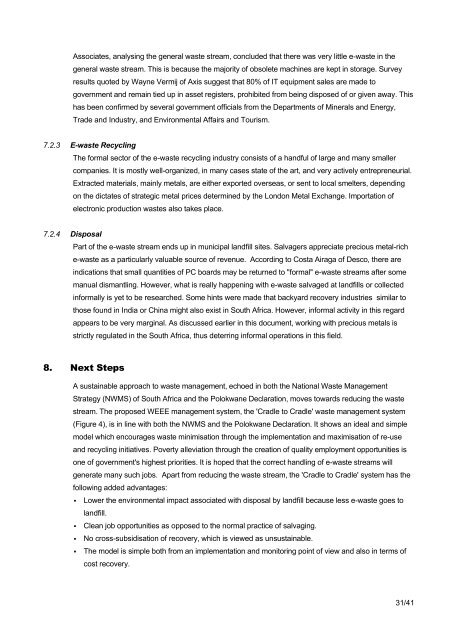E-WASTE ASSESSMENT IN SOUTH AFRICA - e-Waste. This guide
E-WASTE ASSESSMENT IN SOUTH AFRICA - e-Waste. This guide
E-WASTE ASSESSMENT IN SOUTH AFRICA - e-Waste. This guide
Create successful ePaper yourself
Turn your PDF publications into a flip-book with our unique Google optimized e-Paper software.
Associates, analysing the general waste stream, concluded that there was very little e-waste in thegeneral waste stream. <strong>This</strong> is because the majority of obsolete machines are kept in storage. Surveyresults quoted by Wayne Vermij of Axis suggest that 80% of IT equipment sales are made togovernment and remain tied up in asset registers, prohibited from being disposed of or given away. <strong>This</strong>has been confirmed by several government officials from the Departments of Minerals and Energy,Trade and Industry, and Environmental Affairs and Tourism.7.2.3 E-waste RecyclingThe formal sector of the e-waste recycling industry consists of a handful of large and many smallercompanies. It is mostly well-organized, in many cases state of the art, and very actively entrepreneurial.Extracted materials, mainly metals, are either exported overseas, or sent to local smelters, dependingon the dictates of strategic metal prices determined by the London Metal Exchange. Importation ofelectronic production wastes also takes place.7.2.4 DisposalPart of the e-waste stream ends up in municipal landfill sites. Salvagers appreciate precious metal-riche-waste as a particularly valuable source of revenue. According to Costa Airaga of Desco, there areindications that small quantities of PC boards may be returned to "formal" e-waste streams after somemanual dismantling. However, what is really happening with e-waste salvaged at landfills or collectedinformally is yet to be researched. Some hints were made that backyard recovery industries similar tothose found in India or China might also exist in South Africa. However, informal activity in this regardappears to be very marginal. As discussed earlier in this document, working with precious metals isstrictly regulated in the South Africa, thus deterring informal operations in this field.8. Next StepsA sustainable approach to waste management, echoed in both the National <strong>Waste</strong> ManagementStrategy (NWMS) of South Africa and the Polokwane Declaration, moves towards reducing the wastestream. The proposed WEEE management system, the 'Cradle to Cradle' waste management system(Figure 4), is in line with both the NWMS and the Polokwane Declaration. It shows an ideal and simplemodel which encourages waste minimisation through the implementation and maximisation of re-useand recycling initiatives. Poverty alleviation through the creation of quality employment opportunities isone of government's highest priorities. It is hoped that the correct handling of e-waste streams willgenerate many such jobs. Apart from reducing the waste stream, the 'Cradle to Cradle' system has thefollowing added advantages:▪ Lower the environmental impact associated with disposal by landfill because less e-waste goes tolandfill.▪ Clean job opportunities as opposed to the normal practice of salvaging.▪ No cross-subsidisation of recovery, which is viewed as unsustainable.▪ The model is simple both from an implementation and monitoring point of view and also in terms ofcost recovery.31/41
















